
Pune. 17 January 2020. Antarctica, the seventh continent, is the coldest, driest, highest, windiest and the most mysterious continent in the world. It has a total area 14.5 million sq km, which is equal to that of India and China put together. It experiences temperatures as low as – 89 degree C, winds as fierce as 320 Km /h accompanied by snow blizzards, deep crevasses, and many types of mysteries like Aurora Australis, optical illusions, mirage effect, polar days and nights of many months along with a number of buried lakes under 2.5 to 3 Km of ice sheet. Accompanied by all the superlatives, it has many scientific mysteries and abundance of mineral resources like hydrocarbons and metal ores including gold. Monstrous icebergs keep calving off from its ice shelves and move Northwards to warmer regions. These could become a big source of potable water to many countries especially those in the Southern Hemisphere.
Aim Of The Expedition And Conduct
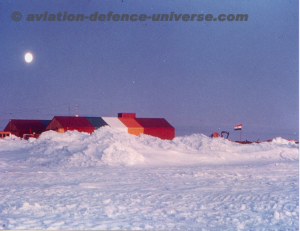
Exploration of this continent poses a big challenge to mankind. Looking at the severity of the problem, the nation awarded the task of establishing a research station on an ice shelf to the Indian Armed Forces, to serve as the base for further exploration, in 1983. The allotted task, besides many research and data collection activities, involved construction of a research station on the ice shelf, commissioning of life support systems and running the station, round the year for as long as possible. I, as a proud Bombay sapper, volunteered for leading the first Indian wintering party in the dual role of a leader and glaciologist. Earlier, India had sent two expeditions in 1981 and 1982, which stayed there for just 9 and 56 days respectively. However, these served as a confidence building measure for sending an expedition for establishing a permanent station and undertaking year-round research in this mysterious continent.
The Vision
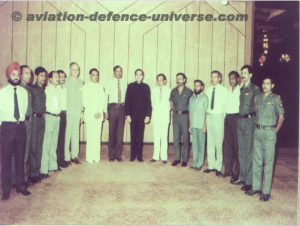
Exploration of Antarctica had been going on in some form or the other under the exploratory progammes of some nations for the last two centuries. However, under the UN charter in the International Geophysical Year in 1957, it was taken up in an organized manner when a permanent station Amundson- Scott was established by the USA at the Geographical pole at 90 degree South and a station Vostok by USSR at the Geo-magnetic Pole at 78 degree 28 ‘ S 106 degree 49’ W. In the same year some other countries made the beginning of having their own stations at different locations on the polar ice cap, ice shelf and Antarctic Peninsula. In the same year to govern the conduct in Antarctica, under the UN charter, a treaty known as Antarctic Treaty was drafted and signed by the countries involved in Antarctic research. The treaty came into force from 1961. For conducting and coordinating the scientific programme, a committee known as Scientific Committee for Antarctic Research (SCAR) was formed whose membership was restricted to only those countries who have substantial achievements in Antarctic research. One of the conditions for that is to have a permanent station in Antarctica for year-round research. India signed the treaty in 1983 and was granted the consultative status in September 1983 with prior condition of having their own permanent station in the coming year.
Earlier Indian Expedtions
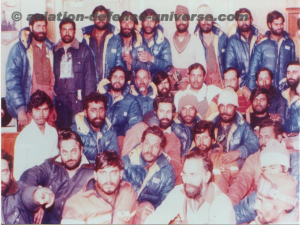
Earlier India had already sent two expeditions in 1981 and 1982 for short durations, which had scientists from various research laboratories for research and service personnel and equipment from defence services for logistics. Scientific data collected and presented in the world forum by the scientists drew a lot of appreciation in India and abroad and necessity to have a permanent set up in Antarctica was felt. This was achieved by the Third Indian Scientific Expedition ( ISAE), which was launched in Dec 1983 with a strength 78 personnel. The expedition was divided in two components, viz summer and winter. The summer component consisted of scientists and service personnel responsible for constructing the station and also research and the winter component out of the same comprising 12 personnel for research and logistics during winter months. The scientific component had the scientists from various laboratories in disciplines like meteorology, oceanography, physics, chemistry, biological sciences, geology, geophysics, glaciology, etc. All the above activities were planned by the high-powered committee of Indian Scientists during planning stage. During the expedition the leader through a group of senior representatives from various laboratories and organisations planned the detailed conduct. It is worth mentioning that coordination of activities was a major task keeping limited resources, logistics and safety in mind. All this required a very high degree of understanding and management skill, which we developed by mutual discussions and deliberations. One way of developing a good understanding was to have a daily coordinating conference in the evening where groups were required to make presentations of their programme, methodology, resources required and the time frame. It is worth pointing out that all discussions during journey and during stay in Antarctica were very educating and fruitful in achieving the overall success.
The Longest Duration Expedition During Winter

The wintering party of 12 personnel, consisted of two civilian scientists, three personnel from EME, three from Engineers, one from Signals, one from ASC and one medical officer from the Indian Navy. They undertook the task of running the station efficiently with smiling faces in spite of the hostile conditions. They achieved the milestone of flying the Indian tri- colour, round the year for the first time on the icy continent. The team set a good example of team spirit, dogged determination, overcoming many hazards, and came out with flying colours. While the team was going through severe blizzards, extreme low temperatures and burial of the entire station in ice due to a snow drift, we were fortunate to receive a telephone call from the then Prime Minister Indira Gandhi, who took a lot of interest in our activities. She spoke in very kind and encouraging words, which were morale boosting and assuring us of the Nation’s support.
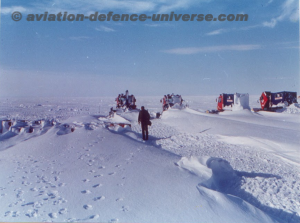
The construction party comprised the personnel of Engineers, EME, Signals and ASC, led by Maj Pawan Nayar, a Bombay sapper, who had been a part of an earlier expedition and who had played an important role in the structuring and training of the construction party. The expedition had teams of Indian Navy and Indian Air Force in supporting role for providing air support. The task, right from digging in ice, construction of the superstructure, installation and commissioning of all the life support systems was completed in a record time of 45 days between 30 Dec 1983 and 15 Feb 1984. During this phase, the site was rocked by severe snow blizzards, low temperatures and the crash of a helicopter with consequent loss of construction material in sea. Undaunted by all this, the team displayed high morale and dogged determination to meet the deadline and running all the systems before handing over to the first ever wintering party.
Having accomplished the task, the team handed over the station to the leader of the Second Wintering Party, Lt Col P Kumresh, a Bombay Sapper, on 01 March 1984 and returned to Goa on 28 March after spending 16 months in the continent, to a warm welcome by the nation.
The Nation Acclaims
The team’s efforts were recognized by the nation by awarding, one Kirti Chakra, two Shaurya Chakras, five Sena Medals ( Gallantry ), one VSM and one Commendation Card, besides civilian awards to the two scientists. The team’s efforts resulted in the country being granted a consultative status in the International Forum of Antrarctic Exploration and Research.
Accidents And Misadventures.
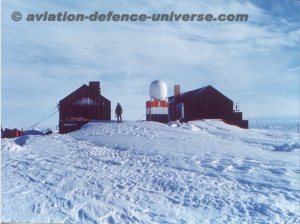
In spite of all coordination and precautions, we had our share of mishaps and setbacks, but we overcame all that through overall coordination. The major disaster was crash of a MI 8 helicopter into the Antarctic see on 29 Dec 1983 next to the ship. But the presence of mind of some and cooperation resulted in the rescue of all. Another major setback was during the winter months when part of the roof of the newly constructed generator room was blown off during blizzard that resulted in ingress of jet of snow in the generator shed. This was timely repaired by the Engineer team. Another alarming mishap was damage of the coupling of two of the three generators during testing and installation, which was alarming as we were left with only one serviceable generator. This was overcome through improvisation by the EME team. In later part in January 1985, landing gear of an MI 8 helicopter was damaged during whiteout.
We also had our share of injuries to our wintering team members. Notable of that was the spurt of acid on the eyes of our electrical in charge JCO while changing the battery terminals. But the good care by the medical officer saved his eyes. Likewise, there were major injuries to some members due to exposure to extreme cold but good planning and timely advice saved us all.
Lessons Learnt
Some of the lessons learnt are mentioned below:
- Indian Antarctic programme is a scientific programme aimed at investigation of certain scientific objectives. Side by side it is also aimed at preparing an inventory of mineral resources available in that continent and in close vicinity. All participating agencies, specially the services, should aim at extending maximum support to the scientists.
- Participation of defence services is in supporting role and they should go fully prepared to extend full cooperation.
- Success of the expedition depends a lot on the logistic planning which is done before launch of the expedition. Services should create cells in their organizations for smooth planning and conduct.
- During expedition and stay in Antarctica, all personnel are equal irrespective of their rank, seniority and colour of uniform. The team members should accordingly plan all activities so that mutual respect is maintained and sentiments of any one are not hurt.
- All scientific and other tasks should be done in a team and at no stage anyone should be allowed to venture alone.
- All activities like cooking, cleaning etc should be shared by all equally irrespective of any distinction.
- Members should be vigilant at all times and observe all prescribed precautions and adhere to the environmental rules as laid down in the treaty. Constructive discussions, cultural activities for a healthy and harmonious living should be observed.
For a detailed report and the first-hand experience of the author, one can read the book ‘ Breaking the Ice in Antarctica, the first Indian Wintering by Indians in Antarctica ‘, available in the Bombay Sapper’s library.





















































































































